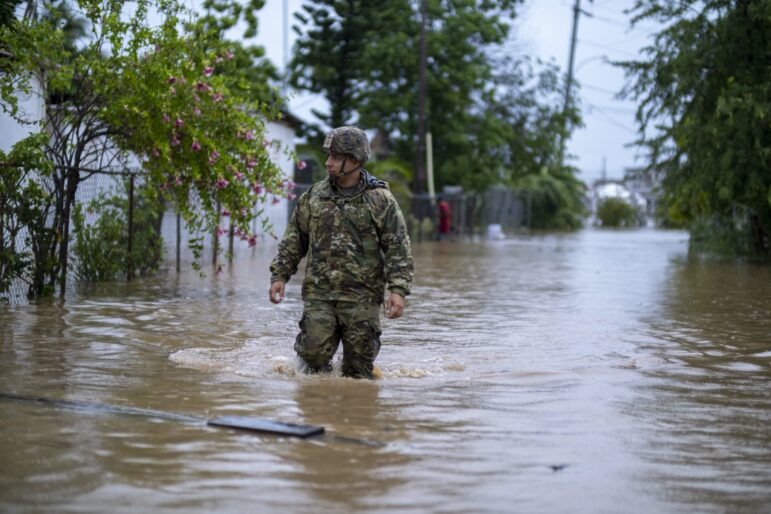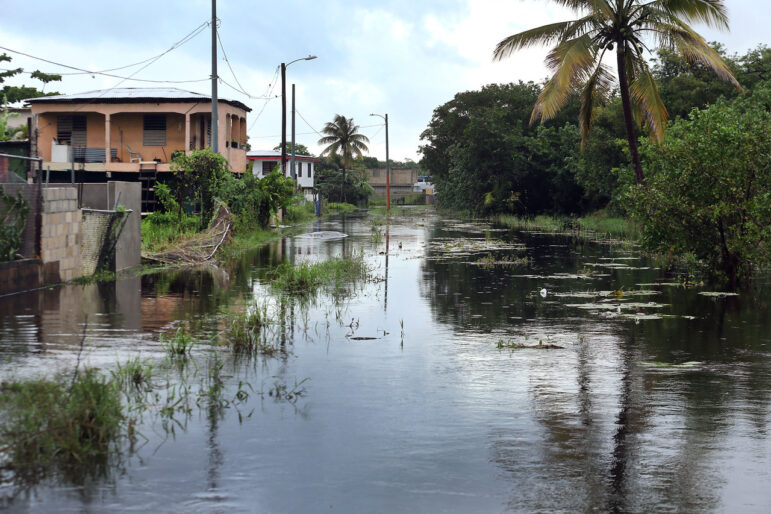On the fifth anniversary of the devastation caused by Hurricane María, Puerto Rico woke up Monday with a new catastrophe whose dimension remains to be seen as there are still bands of rain expected from Hurricane Fiona.
The evening of Sunday, September 18, closed with messages on social networks from desperate people who urgently needed help, particularly from the coast of Salinas and Santa Isabel, in the South, because they were trapped by the floods created by rain that did not stop falling for more than 24 hours, combined with storm surges hitting their homes.
Around 8:30 p.m., Patria Astacio, a resident of Villa Sol Street in the Playita neighborhood in Salinas, left her house and noticed a flashlight shining on her from her neighbors’ house.
“I saw that it was Don Juan and I yelled at him. He told me that he got up to urinate and realized that the water was up to his knees,” Astacio said.
Juan Beltrán, 78, lives with his wife Providencia Beltrán Silva, 69, and his mother-in-law, Rosalinda Silva, 94, who suffers from Alzheimer’s disease.
“Thanks to Patria we stayed at her house. This morning we came home. My husband got up and we came to see the incredible mess. We were horribly flooded. This was a disaster,” said Beltrán Silva. The couple told the Center for Investigative Journalism (CPI, in Spanish) that the water reached two feet inside their home. They said it was the first time the water covered the road and flowed inside the house. It did not even happen when Hurricane María made landfall in 2017.
“I’m thinking it was because of the amount of rain. There’s a ditch behind the community that collects the water that comes from the town and when it meets the Nigua River, it makes everything a disaster,” Astacio said. These Salinas residents said around 200 people live on Villa Sol Street in 20 houses that suffered damages.
As of Monday morning, no one from the Emergency Management Bureau or the municipality had visited them. Astacio said only one fire truck went by but did not stop.
“They didn’t come; They passed but didn’t stop. They don’t pay attention to us,” added Beltrán Silva, while warning that the water was accumulating again in the street.

Photo by Ricardo Arduengo | Centro de Periodismo Investigativo
However, he said he prefers to stay at home and not go to a shelter. “If it floods again, we’ll go back to Patria’s house,” he said.
In the mountains, river overflows, landslides, and road sinkholes were the reason for most of the calls for help. In some cases, the response came from the government and in others, from relatives, friends, or neighbors who, desperate, decided to act due to the imminent life risks they saw.
The rain accumulation up in the mountains produced an extraordinary current that caused many rivers to overflow, but also caused rivers and reservoirs to overflow, which on their way to the ocean, flooded residential and commercial areas in several municipalities.
The National Weather Service (NWS) was still issuing flood warnings in the morning for the towns in the north and eastern central region, including Caguas, Carolina, Gurabo, Juncos, Las Piedras, San Lorenzo, Arecibo, Utuado, Comerío, Dorado, Naranjito, Toa Alta, Toa Baja, Corozal, Morovis, Vega Alta and Vega Baja because the Río Grande de Loíza and Río Grande de Arecibo overflowed their banks, as well as La Plata — the island’s longest river — and the Cibuco river, in the central north region.
At press time, several sectors were still cut off by landslides or because rainwater flooded the roads.

Photo by Ricardo Arduengo | Centro de Periodismo Investigativo
As happened five years ago, when the powerful Category-5 Hurricane María passed through Puerto Rico, the entire archipelago was left without electricity service. The number of homes without drinking water service also increased as the hours passed.
No electrical or water service
The government attributed four deaths to the storm from Saturday to Monday. A 77-year-old man died in the shelter at the Escuela Ecológica in the island-municipality off the eastern coast, Culebra; an 88-year-old woman died when she went into respiratory failure at the shelter enabled at the Eugenio María de Hostos school, in Mayagüez on the west; A 70-year-old man lost his life at his home in Arecibo in the north coast when his electric generator exploded and another 58-year-old man, died when he fell into a ravine behind his house in Comerío, in the central mountainous region, according to the police.
The private and public sectors’ operational routines were practically halted by the cyclonic event that began to affect Puerto Rico on Sunday morning as a storm, which initially sat 33 miles from Ponce, and at 3:20 p.m., entered and exited Cabo Rojo in the west near Punta Tocón, as a Category-1 hurricane with winds of up to 113 miles per hour, NWS Meteorologist Emanuel Rodríguez González said.
The catastrophe being experienced in this Caribbean Island is not only the result of the nearly 25 inches of accumulated rain that fall, but also because of unfinished or uninitiated mitigation projects five years after the devastating Hurricane María.

Villa Santos Sector, Upper Middle, in Loíza.
Photo by José “Pipo” Reyes | Centro de Periodismo Investigativo
In the archipelago, there are 3,646 houses still covered in blue tarps, plus an undetermined number of unrepaired homes.
This is compounded by the un-dredged lakes and reservoirs, communities that were never relocated away from the dangerous areas and constructions in the maritime-terrestrial zones.
Planning for the disaster
Roberto Thomas Ramírez, spokesman for the Iniciativa de Ecodesarrollo de Bahía de Jobos (IDEBAJO), told the CPI radio program Agenda Propia that the rain flooded areas in Salinas that had never been affected by floods before. The community leader said the situation was aggravated by land movements in several sectors that alter the flow of runoff. He also argued that the destruction of the mangrove area on the coast of Salinas further increased the effects of the rain brought by Fiona and made the communities more vulnerable to catastrophic events.
“All the solar farms that the Salinas government is setting up and promoting compact the land and prevent the water from percolating and, so, those waters end up in our communities,” he said.
For Thomas Ramírez, another factor has been “the environmental rampage carried out on the coast for tourism purposes that have put people at risk. These people invest in setting up an Airbnb [short-term rentals] and when the hurricane comes, they leave.”
According to Thomas Ramírez, “the unresponsiveness from the Department of Housing, FEMA and COR3 and all the agencies that were called to solve what happened because of María should all, right now, be legally charged for what is happening in Salinas because it’s an irresponsibility that five years later, conditions still create this type of vulnerability.”
“I don’t want to see fake tears from any politician. They have had policies in place here for years that affect our communities,” said the IDEBAJO coordinator.
Several municipalities along the island’s western region, such as Añasco, Mayagüez and Cabo Rojo, are among the most severely hit by the hurricane’s rains.
There was also catastrophic damage in Loíza, on the northeastern coast, including those who were just recovering from the losses that María caused to their dwellings. Loíza Community Leader Modesta Irizarry said Fiona landed when the town’s families were still slowly recovering from the effects of Hurricane María, which left blue tarps covering their roofs and others with significant filtration problems in their cement ceilings, and those who lost everything.

Photo by José “Pipo” Reyes | Centro de Periodismo Investigativo
“In other words, we’re re-starting this process and now we’ll see, really, how important it is for the government that our people recover,” Irizarry commented. “The process has been very difficult because people were recovering, others were in the process and others were starting because there are people who are still rebuilding their homes,” she insisted.

Photo by José “Pipo” Reyes | Centro de Periodismo Investigativo
“It’s heart-wrenching how at this point, when we’re supposed to be much better after the experience of hurricanes Irma and María, the earthquakes and the pandemic that we have gone through, that something so ironic happens to us, that so many families that were still in that recovery process lose everything again,” she said. “Others who hadn’t lost anything are losing [now with Fiona],” she added.
Irizarry believes that in these natural events, some complications are attributed to individuals whose responsibility lies within the State. “People were promised help in the recovery, for which so much money supposedly exists and has not been used,” she said.

Photo by José “Pipo” Reyes | Centro de Periodismo Investigativo
The US government allocated $21 billion in permanent works funds for the reconstruction of the damage that Hurricane María caused, of which after five years, barely $700 million, or 3.2%, have been used.
The government estimated the number of deaths related to Hurricane María at 2,975, many associated with the effects of the lack of electricity on people’s health. On Sunday, as Fiona passed through Puerto Rico’s southern region, the Medical Center in Río Piedras, a San Juan suburb and the island’s main public hospital facility, was in darkness. Health Secretary Carlos Mellado said the electric generator did not fail, but that the medical institution had problems with the transfer switch. The Health chief did not explain what the protocol is to verify the operation of this equipment from the time a hurricane watch is issued.
In addition, there were failures with the generators of the local Diagnostic and Treatment Centers (CDT, in Spanish) in Guánica and Cabo Rojo. As of Monday, Mellado still did not know what was going on in Guánica, but said a technician was supposed to have gone there to evaluate the problem. He added that if the generator cannot be repaired, he had already asked Orlando Olivera, coordinator of the Federal Emergency Management Agency’s (FEMA, in English) Caribbean Office in Puerto Rico, to deliver a generator.
Meanwhile, Mellado said that on Sunday night, he spoke to Metro Pavia’s administration staff, which is responsible for the CDT. He alleged that an attempt was made to send a generator with a PREPA brigade, but it was not possible due to the weather.

Photo by José “Pipo” Reyes | Centro de Periodismo Investigativo
“We will have to look into what the failure was, if there was any kind of negligence by the centers or hospital, but we must remember that hospitals are private,” said the Health Secretary to questions from the CPI at a press conference.
He said CDT’s have a backup generator, while hospitals have two. Mellado added that the plan establishes that the generators must be turned on weekly for one hour, a maintenance log must be kept, and there must be a supply (of fuel) for three or four days.
Reporter Omaya Sosa Pascual contributed to this story.
Vanessa Colón Almenas is a corps member of Report for America.
Próximo en la serie
2 / 8
¡APOYA AL CENTRO DE PERIODISMO INVESTIGATIVO!
Necesitamos tu apoyo para seguir haciendo y ampliando nuestro trabajo.


